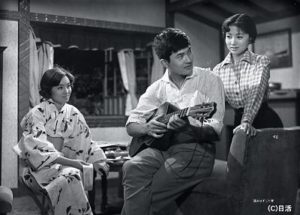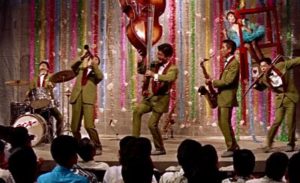STUDIO: Arrow | DIRECTOR: Seijun Suzuki | CAST: Sachiko Hidari, Akira Kobayashi, Koji Wada, Tamio Kawaji, Ken Yamauchi, Masako Izumi, Michi Azuma
RELEASE DATE: 2/13/18 | PRICE: Blu-ray/DVD Combo $69.95
BONUSES: Analysis of the films and Suzuki’s career by historian Tony Rayns, 60-page illustrated collector’s book featuring new writing by critic and author Jasper Sharp
SPECS: NR | 450 min. | Foreign language crime/drama | 2.35:1 widescreen | mono | Japanese with English subtitles
Those who are familiar with the wild, subversive, pop art films that Seijun Suzuki made from 1963 to 1967 will be surprised by four of the five films found in this indispensable set, which is part of a two-volume collection from Arrow (the second volume is set to be released in April). The first four films contained in Seijun Suzuki: The Early Years, Vol. 1: Seijun Rising: The Youth Movies are both entertaining and gorgeously shot — Suzuki worked exclusively in widescreen format — but the plots are rendered in a straightforward fashion, without the customary “winks” that Suzuki included in his best-known films.
All of the films included here are melodramas and two are among the most “normal” Suzuki films seen on DVD in the U.S. The first of these is the earliest film in the set, The Boy Who Came Back (1958). The plot concerns a teen who is a released from prison and is watched over by a charitable young woman who serves as a volunteer probation officer, encouraging him to avoid his yakuza pals.
Boy is the kind of formulaic, family-friendly gangster picture that Suzuki later “exploded” with fragmented storylines, jarring imagery and sublimely frenzied editing. Here, he takes the storyline seriously — as when the hero’s love-object is supposed to have been gang-raped by his ex-friends. We learn shortly after the horrific incident is mentioned that it never took place because the police arrived in the nick of time.
The ornately titled The Wind-of-Youth Group Crosses the Mountain Pass (1961) is a brightly colored variation on the “rambunctious youth tries to avoid a life of crime” formula. It finds our rambunctious youth meeting up with a down-on-their-luck traveling magic show troupe, whom he helps to remain afloat and out of the clutches of (who else?) local yakuza.
Wind is a beautifully shot picture that transcends its rather tame storyline with a jazzy score, a marvelous color palette and dreamy sequences in which Suzuki experiments with the fragmentation that later became the centerpiece of his style.
Teenage Yakuza (1962) has the best title of any film in this set and is the most blatantly entertaining, thanks to its super-simplistic plot, its B-movie running time (71 minutes) and the inclusion of many “twist” sequences. In this case, our teen hero choses to fight against the local gangsters by becoming a “bodyguard” for the put-upon local store owners. The film demonstrates that by ’62 Suzuki had perfected his method of presenting crazy fight scenes — in this case the hero fights his ex-friend in a field.
The fourth entry, The Incorrigible (1963), is the second completely “normal” film in the set. Based on a noted novel by Toko Kon and set in the “Taisho period” in the 1920s (when the Japanese started wearing Western fashions and some became devoted to Western culture), the film is a full-blown “meller” in which a troublemaking (but decidedly non-criminal) teen faces off against school bullies and pursues his dream girl.
In the one onscreen supplement contained here, Asian cinema expert Tony Rayns declares The Incorrigible to be a major turning point in Suzuki’s career, as it was the first time he was able to adapt material of his own choosing. Most likely because this was such an important moment for the filmmaker, he felt compelled to not subvert the material he was presenting.
This surprisingly reverent attitude toward such innocuous material makes The Incorrigible a singularly rigid film, thus qualifying it as a film that Japanese cinema lovers will either embrace (if they seek a Suzuki film that is totally linear and not experimental) or reject (if they’re looking for traces of Suzuki’s familiar stylistic “explosions”).
For the latter group, the normalcy of The Incorrigible is counterbalanced by the most radical and essential film in the set, Born Under Crossed Stars (1965). Made during Suzuki’s most fertile (and frenzied) period, the film is a fascinating reworking of the elements of The Incorrigible. (Rayns calls it “a raunchy remake”). It is based on another novel by Toko Kon and contains a very similar storyline, although it is definitely not a sequel.
Another teen pursues his dream girl here, but this time he also sleeps with the “bad girl” in a series of wonderfully farcical scenes in which he is depicted as a ridiculously puritanical prig.
The film is kinetic to the extreme, especially in its imagery, which switches from long shots/long takes (for essential material from the novel) to eccentrically edited humor and mayhem (clearly Suzuki’s variations on a theme he and his audience were all too familiar with). One is instantly struck by the absurdist sense of humor that distinguishes Born from the other films in this collection.
The featurette with Tony Rayns provides valuable background info about the quintet of films in the set. He outlines Suzuki’s development from a mostly anonymous director of “program pictures” to the subversive master who now has a strong cult in the West.
Rayns is honest about the films he likes and dislikes — he finds Teenage Yakuza not “terribly compelling” — but still emphasizes the importance of each film to Suzuki’s career (and notes that the films have not only never been legally released in the West, but have never even been on DVD in Japan).
He adds a wonderfully gossipy note to this discussion of the filmmaker (whom he interviewed several times). He notes that Suzuki declared that three things distinguished his subversive era: a desire to “stand out” from the other directors at the Nikkatsu studio, the privilege of adapting novels he admired, and a major resentment toward Shohei Imamura, who came from the same class of directors but was allowed by Nikkatsu to make A-features very early on.
|
Buy or Rent Seijun Suzuki: The Early Years, Vol. 1: Seijun Rising: The Youth Movies
|
|---|


Leave a Reply